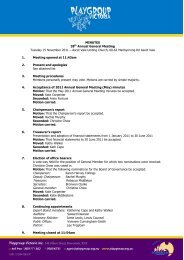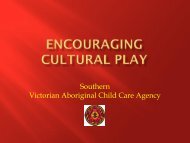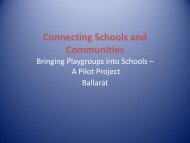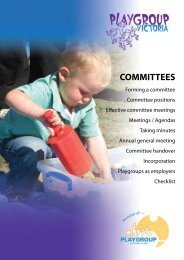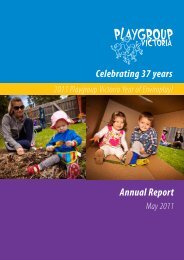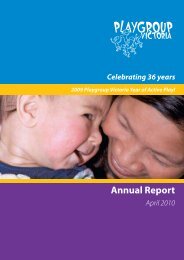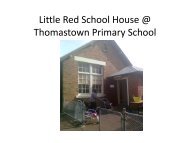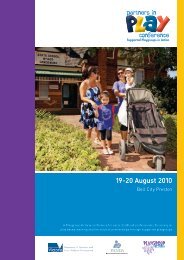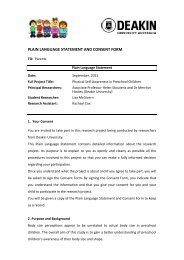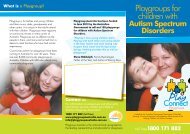to view ESSENTIAL READING on this module - Playgroup Victoria
to view ESSENTIAL READING on this module - Playgroup Victoria
to view ESSENTIAL READING on this module - Playgroup Victoria
Create successful ePaper yourself
Turn your PDF publications into a flip-book with our unique Google optimized e-Paper software.
SAFE AND SUPPORTIVE PLAYGROUPS<br />
C<strong>on</strong>trol hazards<br />
Hazard c<strong>on</strong>trol<br />
Always make it part of your regular routine <str<strong>on</strong>g>to</str<strong>on</strong>g> check<br />
all indoor and outdoor play areas for possible hazards.<br />
This is particularly necessary when other groups share<br />
the playgroup room. If you find a hazard remove,<br />
repair, replace or restrict access.<br />
Minimise the risks<br />
If hazards cannot be removed, put up barriers <str<strong>on</strong>g>to</str<strong>on</strong>g><br />
protect children. Use fences, gates, guards, doors,<br />
covers, locks, child restraints, c<strong>on</strong>tainers and<br />
cupboards.<br />
Keep dangerous objects at least 1.5m above floor level<br />
and remove anything children could use <str<strong>on</strong>g>to</str<strong>on</strong>g> climb <str<strong>on</strong>g>to</str<strong>on</strong>g><br />
that height. Latches <strong>on</strong> gates and doors should be more<br />
than 1.5m high. Gates should be self closing and self<br />
locking.<br />
Place a ‘Hold My Hand’ sign <strong>on</strong> the inside of the gate.<br />
Signs available from Uniform Safety Signs, call 9354<br />
0016.<br />
Be prepared<br />
Have ph<strong>on</strong>e access<br />
Display your emergency acti<strong>on</strong> plan and emergency<br />
ph<strong>on</strong>e numbers in a prominent positi<strong>on</strong>. See<br />
‘Emergency acti<strong>on</strong>’ <strong>on</strong> page 67 and the checklist <strong>on</strong><br />
page 74. Regularly check that the informati<strong>on</strong> is<br />
current.<br />
If a ph<strong>on</strong>e is not available at the playgroup venue<br />
arrange for a member <str<strong>on</strong>g>to</str<strong>on</strong>g> carry their mobile ph<strong>on</strong>e or<br />
make arrangements with nearby residents.<br />
Have a first aid kit<br />
Be sure <str<strong>on</strong>g>to</str<strong>on</strong>g> have a playgroup first aid kit available.<br />
Regularly replace used and out-of-date items.<br />
Suitable kits can be purchased from St John<br />
Ambulance or Kidsafe. See ‘Safety resources’ <strong>on</strong> page<br />
68 and ‘Recommended c<strong>on</strong>tents for a general first aid<br />
kit’ <strong>on</strong> page 66.<br />
C<strong>on</strong>sider having first aid charts displayed and some<strong>on</strong>e<br />
in the group trained <str<strong>on</strong>g>to</str<strong>on</strong>g> handle emergencies.<br />
St John Ambulance and the safety centre at<br />
Melbourne’s Royal Children's Hospital run first aid<br />
courses. See page 68 for ph<strong>on</strong>e numbers.<br />
Have a fire evacuati<strong>on</strong> plan<br />
Use the standard fire orders for playgroups <strong>on</strong> page 66<br />
<str<strong>on</strong>g>to</str<strong>on</strong>g> write an emergency acti<strong>on</strong> plan for your playgroup.<br />
Display the plan and regularly practise the fire drill.<br />
Know where all fire extinguishers are and be sure<br />
every<strong>on</strong>e knows how <str<strong>on</strong>g>to</str<strong>on</strong>g> use them. Check that<br />
emergency exits are clearly labelled and not blocked.<br />
External fires<br />
If you are in a high bushfire danger area have a policy<br />
regarding cancelling the playgroup <strong>on</strong> high fire danger<br />
days.<br />
Record<br />
Have a book available <str<strong>on</strong>g>to</str<strong>on</strong>g> record any incidents or<br />
injuries while they are fresh in members’ minds. If an<br />
insurance claim eventuates <strong>this</strong> informati<strong>on</strong> is very<br />
important.<br />
When recording an incident include dates, times,<br />
place, people present, acti<strong>on</strong> taken and signatures.<br />
Two adults should complete a signed, eye witness<br />
account wherever possible. See ‘Accident, incident or<br />
injury record’ <strong>on</strong> page 130.<br />
Plan emergency transport<br />
Plan ahead how you would transport an adult or child<br />
in an emergency situati<strong>on</strong>.<br />
Keep numbers manageable<br />
Ask families <str<strong>on</strong>g>to</str<strong>on</strong>g> sign in and out in your attendance book<br />
so that in an emergency you can quickly see if every<strong>on</strong>e<br />
is accounted for.<br />
Avoid overcrowding as it can cause c<strong>on</strong>fusi<strong>on</strong> in an<br />
emergency.<br />
64 <strong>Playgroup</strong> Manual



